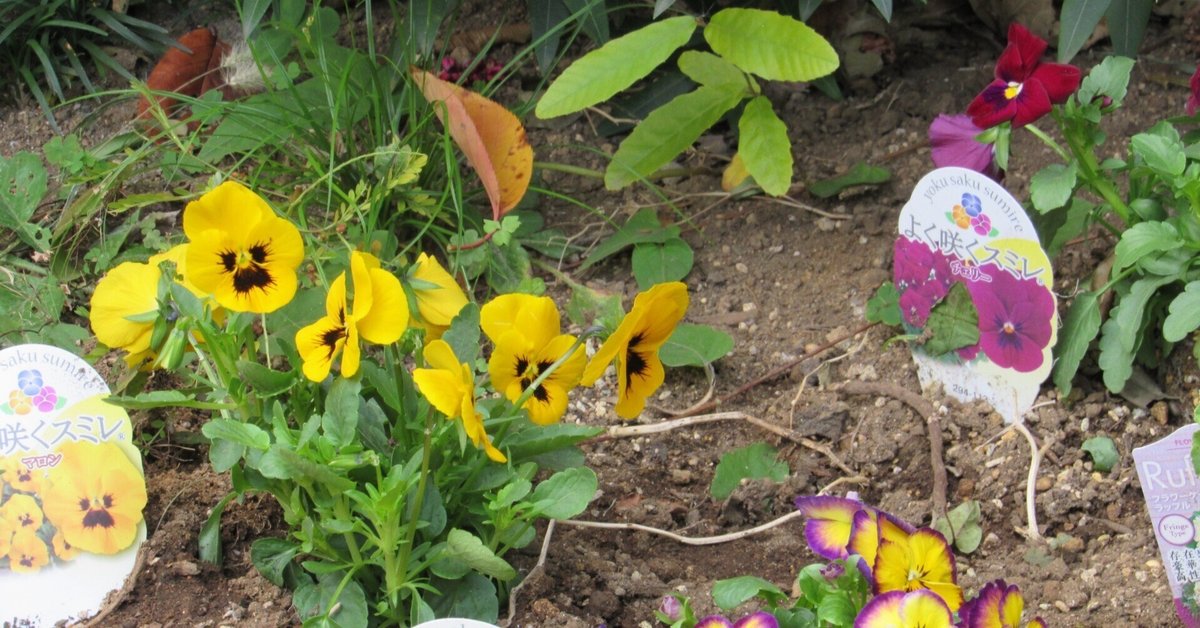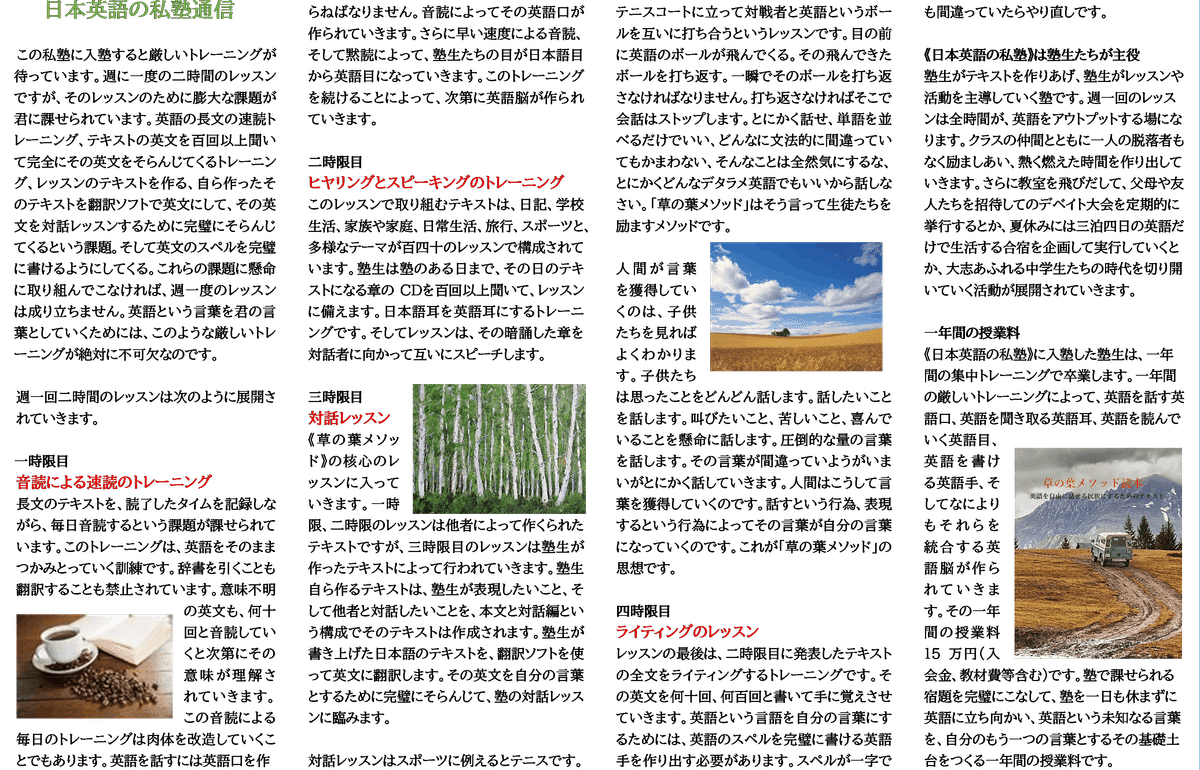
草の葉メソッドに取り組ためのガイド
1 ラーナー(learner──学習者)はテキストの日本語を翻訳ソフトで英語に転換させ、自分の言葉(英語)を作りだします。テキストの日本文を正確に訳す必要はありません。テキストの日本文を独自に展開させて、まったく違った英語に転換してもかまいません。むしろその展開をすすめます。なぜならそれが自分の言葉を作り出すことですから。
2 現在の翻訳ソフトは相当進化していますが、いまだ開発途上の装置であり、打ち込んだ日本語がすべて正確に翻訳されてくることはありません。単文や短文は比較的精度の高い英文を打ち出してきます。しかし長い文章(重文や複文)は、混乱した英文に変換されてきます。そのときラーナーは、その長文を短文に分解してつなげたり、その長文と同じ意味をもつ翻訳されやすい文章に書き換えたりして、自分が表現できる英文を作り出します。テキストの文章とまったく異なっていてもかまいません。
3 その転換された英語が、正しい英語なのか、間違った英語なのかと思案したり危惧したりする必要はありません。「草の葉メソッド」の目的は、間違った英語を大量に話すということにあり、間違った英語こそ正解であるという思想によって組み立てられているのです。
4 翻訳ソフトでつくりだしたその英文をそらんじることが、ラーナーに課せられています。翻訳ソフトはその英文を音声によっても表現されています。その発音を参考にしながら、完全にそらんじてレッスンにのぞんでください。対話レッスンは、その英文を互いに伝えあうことからはじまりますから、この課題をクリアーしていないとレッスンが成り立ちません。
5 レッスンは続いて対話編に入り、対話者はそれぞれAとBになって会話をします。ですからこの対話編の英文もまたそらんじておかねばなりません。本文のテーマをさらにふくらませ、フリートークではテキストで話題にされているような話をさらに広げて、豊かな会話を展開してもらいたいという目的をもって編まれています。
6 この二つの課題を終えると、フリートークになります。テニスにたとえると、英語というボールを自由に打ち合うというレッスンです。対話レッスンは、飛んできたボールを即座に打ち返さなくてはなりません。日本語に置き換える時間などありません。日本語脳でプレーするのではなく、英語脳でプレーする訓練です。
7 対話は互いに質問を投じることによって展開されていきます。ですからラーナーは対話者に問いかける力、対話者から話を引き出す力、質問をつねにくり出す力を鍛えておく必要があります。たとえば対話者が船で世界一周の旅をしてきたといった話題を切り出してきたとき、「何日間の船旅だったのですか、どことどこを回ってきたのですか、費用はどのくらいかかったのですか、船上の毎日はどんな生活だったのですか、どんな人たちが乗りこんでいるのですか」などなど。会話を豊かにしていくのは、どれだけ多様で豊かな質問を発することができるかにあります。
8 対話レッスンは多数の人と対話できるように組み立てます。一回の対話時間を十分とタイム設定にすると、一時間のレッスンで、四、五人と対話することになります。最初は、互いにぎこちない、とぎれとぎれの、ぎこちない会話ですが、二人目、三人目と対話を重ねるたびにその会話が滑らかに自信をもった言葉を投じ合うようになり、滑らかにその会話が弾んでいきます。
9 《草の葉メソッド》には、学校や語学教室で教える先生という役割を担う人は存在しません。このメソッドに取り組むラーナーの一人一人が、彼らの英語を作り出す翻訳ソフトを常に作動して、このレッスンに取り組むラーナーと、会話のラリーによって英語の力を磨きあう場です。ですから《草の葉メソッド》では、ラーナーの一人一人が教師であり生徒です。
10 《草の葉メソッド》は、日本人同士が英語で話すためにつくられたメソッドです。明治時代にアメリカ人が野球を日本に持ち込みましたが、この野球を今日のように興隆させたのは、日本人が日本の野球を創造し、日本各地に広めていったからです。英語という言葉を日本の大地に根ずかせるには同じ道程が必要なのです。「草の葉メソッド」がめざすのは、日本英語の創造です。
11 《草の葉メソッド》の草の葉とは、ホイットマンの詩から取られましたる。草とは何か。ホイットマンはこう書いています。
──草とは不滅の大地に、不滅の力をもたらす生命、不滅の魂を教える神のハンカチーフである。
《草の葉メソッド》によって生まれる日本英語が、三百年かけて日本の大地にくまなく広がっていくとき、日本人は日本語と英語を同時に話せる民族になるという雄大な仮説がいま投じられました。

1
Lerner converts the Japanese text into English using translation software and creates his own words (English). It is not necessary to translate the Japanese sentences of the text exactly. You can develop your own Japanese sentences in the text and translate them into completely different English. we would rather recommend its development. Because it creates its own words.
2
The current translation software has evolved considerably, but it is still a device under development. Therefore, not all the Japanese you type will be translated accurately. Simple sentences and short sentences will produce English sentences with relatively high accuracy. However, long sentences (compound sentences and complex sentences) are converted into confusing English sentences. At that time, the learner breaks down the long sentence into short sentences and connects them. Or rewrite it into a sentence that has the same meaning as the long sentence and is easy to translate. In this way, you make English sentences that he can express yourself. It is good even if it is completely different from the text sentence.
3 There is no need to worry or afraid about whether the converted English is correct or incorrect. The purpose of the "Leaves of Grass Method" is to speak a lot of wrong English, and it is built around the idea that wrong English is the correct answer.
4 The learner must memorize the English sentences created by the translation software perfectly. The translation software also expresses the English sentences by voice. Learners should imitate the pronunciation and memorize it completely before coming to the lesson. A dialogue lesson begins with communicating the English sentences to each other, so the lesson will not be complete unless this task is completed.
5 The lesson will continue into the dialogue section, and the learners will become A and B respectively and have a conversation. Therefore, the English text of this dialogue must also be taken into account. In Free Talking, Lerner develops the themes of the text further and speaks on many topics. It is made with the purpose of having the learners talk about many topics.
6 After completing these two assignments, you will have a free talk. If you compare it to tennis, it's a lesson where you hit the ball of English freely. In interactive lessons, you have to hit back the ball as soon as it hits you. I don't have time to replace it with Japanese. Instead of playing with a Japanese brain, it is a training to play with an English brain.
7 Dialogue is developed by asking each other questions. Therefore, the learner needs to train the ability to ask questions to the interlocutor, the ability to elicit stories from the interlocutor, and the ability to constantly ask questions. For example, when the interlocutor brings up the topic of having traveled around the world by ship, he asks, "How long was the voyage? Where did you go, and how much did it cost? What was life like on board? What kind of people were on board?” and so on. What enriches the conversation is how many diverse and rich questions you can ask.
8 Dialogue lessons will be assembled so that you can interact with a large number of people. If you set the time for each conversation to 10 minutes, you will have conversations with 4 or 5 people in an hour lesson. At first, the conversation is awkward, timid, interrupted, cowardly, but as the second and third people talk, the conversation becomes smoother and more confident, and the conversation flows smoothly.
9 In the "Leaf of Grass Method", there is no one who plays the role of a teacher in schools or language classes. It is a place where each learner working on this method runs the translation software that creates their own English and polishes their English skills through a conversational rally with the learner working on this lesson. So in the Leaves of Grass Method each learner is a teacher and a student.
10 The Kusa-no-ha Method is a method created for Japanese people to talk to each other in English. Americans brought baseball to Japan in the Meiji era, but the reason why baseball has flourished as it is today is because the Japanese created Japanese baseball and spread it throughout Japan. The same process is necessary for the English language to take root in the Japanese soil. The goal of the Kusanoha Method is to create Japanese English.
11 The title Leaves of Grass is taken from Whitman's poem. what is grass Whitman writes: --Grass is God's handkerchief that teaches life, the immortal soul, to the immortal earth that brings immortal power. Today, Japanese English is born by the “Kusa no Leaf Method”. When Japanese English spreads over the land of Japan over 300 years, the Japanese will become a people who can speak both Japanese and English at the same time. That majestic hypothesis has now been cast upon us.




